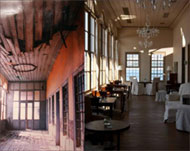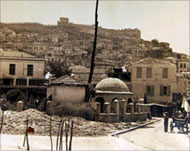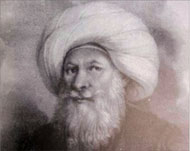Greece rediscovers Islamic treasures
From the eastern Dodecannese island of Mytinene to the northern provinces of Macedonia and Thrace, Islamic monuments long ravaged by weather and neglect are being restored to their former glory in Greece.

Nestled near the road linking Trainaoupolis and Adrianople, lies the oldest mosque in Europe, the Great Temenos.
Built during the reign of Ottoman Sultan Mohammed I, (1413-1421), the rectangular-shaped mosque is depicted as one of the most important and complex wooden structures in the world, but a lack of proper maintenance over the years has contributed to its decay.
Argiris Barkitzis, an architect at the Greek Ministry of Culture, explained that the building has suffered extensive damage due to water penetration and the ravages of time.
Experts have spent the last few years conducting studies on appropriate methods to replace the lead leaves of the roof and reinforce the wooden structure with a metal tower inside.
Renovation projects
In tandem with the mosque renovation, the Culture Ministry has also launched projects to restore the Bezesteni, a covered market for fabrics and luxury goods built in 1385, the Aquaduct in Kavala as well as the Zintzirli mosque and the 15th century Ahmet Pasha mosque in the centre of Serres.
 |
|
The Culture Ministry is restoring |
Similar projects have also been undertaken – with the help of European Union funding – near Komotini with the restoration of the Oruc Beg Hamman built in 1398 and the Komotini mosque, as well as on the island of Mytilene with the restoration of Yeni mosque.
Built by Naziri Moustafa Aga Koulaxizi in the 19th century, the Yeni mosque building is the largest and most recent Islamic site on the island.
An archaeologist from the Culture Ministry who requested anonymity, spoke of effort to preserve such Islamic monuments.
“It has taken a while but Greece has become more sensitive about preservation and has realised that cultural heritage is not restricted to one’s own nationality and it should be worth keeping.”
Neglect
As Greece is situated across the Mediterranean from Libya and Egypt, it became prone to early Muslim raids as the Islamic Empire first began to grow.
It was not, however, until 1453 with the fall of Constantinople – now Istanbul – that Greece was fully brought under Islamic rule, which lasted until the revolution of 1821.
|
“The various Islamic monuments dotting the country are monuments of the world. They are part of the history of this country and people want to see them restored” Argiris Barkitzis, an architect at the Greek Ministry of Culture
|
Greek law affords archaeological protection to any site that can show evidence of antiquity from prehistoric times to 1830, the foundation of the modern Greek state.
In previous decades, however, Greece had sidelined its Ottoman past, highlighting instead its Ancient Greek heritage.
“The various Islamic monuments dotting the country are monuments of the world. They are part of the history of this country and people want to see them restored,” Barkitzis told Aljazeera.net.
The Al Kazar mosque in the northern port city of Thessaloniki operated for years as a pornographic cinema before the Ministry of Culture bought and restored the building, transforming it into an art gallery.
In Drama, the city’s sole mosque was used for decades as a warehouse and was about to be torn down to make room for an apartment complex before officials salvaged it and converted it into a museum.
Re-evaluating history
Health Lowry, chairman of the near eastern studies department at Princeton University, explained: “Throughout most of the 20th century, Greece’s efforts were focused on preserving the Greek aspects of the past and relatively little effort was expanded on the Turkish past.
“While there was never any sustained effort to erase the Ottoman architectural presence, a combination of neglect and other priorities meant that little attention was focused on it. This has changed drastically in the past 20 years.”
 |
|
The old town of Kavala |
One site that has benefited from the change in attitudes in Greece is the Imaret castle in the old town of Kavala.
Built in 1817, the building was a gift from Mohamed Ali Pasha, the viceroy of Egypt, to the town of Kavala, his birthplace.
The Imaret, which means “soup kitchen” in Turkish became the most recognised school of its time within the Balkans, during the last period of the Ottoman Empire.
It consisted of a series of inter-related buildings, including a mosque, higher level colleges, a Hamam or Turkish bath, administrative offices and the soup kitchen itself.
Aside from functioning as a seminary, it also served food to students, the poor and travellers, and it continued to meet the needs of the Muslim inhabitants of the town until the population exchange between Greece and Turkey under the Lausanne Treaty in 1923-1924.
The Imaret had been left in ruins for decades until it was restored in 2004 to become the first hotel operating within a historical building in Greece.
Biggest restoration effort
“The Imaret was unique in that it was built in a relatively small provincial town. While we see similar complexes throughout the Ottoman world in major cities, we do not generally see them is small towns like Kavala,” said Lowry.
The Imaret was first listed as a protected historical monument by Greece in 1954 and for nearly four decades both the Greek and Egyptian governments conducted studies and drew up plans for its restoration but the mammoth project never appeared to leave the drawing board, mainly due to a lack of funds and interest.
 |
| The restored Imaret’s inner pool |
But where both governments failed, one woman succeeded in restoring and preserving the monument after spending six years convincing the Egyptian government that she was capable of such a task. The end result made the Imaret the biggest private restoration effort ever undertaken in Greece.
Barkitzis, the Greek Culture Ministry architect, said: “The Imaret was completely abandoned and a large part of it had collapsed. The Greek government tried many times to pressure the Egyptian government to fix it but there was never enough funding.”
Anna Missirian, the operator of the Imaret said the lack of interest was understandable.
“Greece’s first priority is to allocate funding for the preservation of the Acropolis while Egypt’s is the Pyramids. Unfortunately, the victim in all this was the poor Imaret.”
Saved from decay
The €7 million ($8.5 million) project to transform the monument into a 30-room luxury hotel was not seen by many as a smart investment in a town not widely known by the average tourist, but Missirian said she was haunted by the need to save the Imaret from total decay.
“In restoring the Imaret I wanted to re-create the atmosphere of the period while keeping the historical factors intact,” she said.
 |
|
The Imaret was a gift from Egypt |
Under the watchful eye of archaeologists and architects, the building was restored using the same materials and techniques of the period, often sacrificing the practicality of a hotel for the sake of preservation.
Theodoros Mouryiadis, an engineer with the project, said: “We had to insert plumbing, wiring and ventilation in a manner that would not destroy the walls, the original woodwork or the stone floors of the building and this was extremely difficult.
“The lead sheets covering the doomed roofs, which are crucial to the building’s insulation, were all replaced with traditional methods,” he added.
Missirian said the hotel was secondary.
“I don’t want to give the Imaret the stereotype of a typical hotel because it is a monument first and I will do everything I can to keep it as such.”
Similar restoration techniques were also applied to Mohamed Ali Pasha’s family home, now used as Imaret’s restaurant and cultural centre.
The broad-fronted, two-storey traditional dwelling is one of the few examples remaining in Greece that preserve the distinction between male and female quarters.
Lowry, the Princeton professor, said: “The restoration of Ahmet Ali Pasha’s Imaret in Kavala is one of the best examples of its kind any place in the world.
“A monument that had fallen into complete ruin has not only been immaculately restored, it is now a living, functioning site which fulfils one of its original functions – providing food and lodging to travellers.”
Pictures by Harris Sfougaris